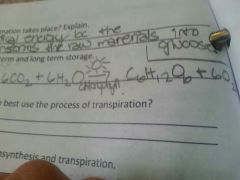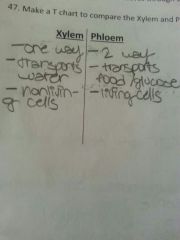![]()
![]()
![]()
Use LEFT and RIGHT arrow keys to navigate between flashcards;
Use UP and DOWN arrow keys to flip the card;
H to show hint;
A reads text to speech;
81 Cards in this Set
- Front
- Back
|
Tropism |
The growth response of plants to their environment due to external stimuli |
|
|
Phototropism |
A plants response to light |
|
|
Geotropism |
A plants response to gravity |
|
|
Dependent Variable |
The outcome, or result of the experiment |
|
|
Independent Variable |
The variable that is being tested, changed |
|
|
Constant |
The materials that stay the same |
|
|
The experimental group |
The group that is being tested |
|
|
The control group |
The group that the experimental group is being compared to |
|
|
Hypothesis |
An educated guess on what you think will happen in the experiment |
|
|
Scale |
What you mark on the axes of a graph |
|
|
Interval |
The rate at which the numbers on a graph are changing |
|
|
Range |
The beginning to end number of data |
|
|
What is an IVCDV chart used for? |
To collect all of the data |
|
|
What is quantitative data? |
Numerical data |
|
|
What is qualitative data? |
Data in the form of observations (like smell, sight, etc) |
|
|
What would you use to measure the mass of something? |
A triple beam balance scale |
|
|
What would you use to measure the amount of something in mililiters? |
A graduated cylinder |
|
|
What would you use to measure the temperature of something? |
A thermometer |
|
|
When do you use a bar graph? |
When you're comparing data |
|
|
When do you use a line graph? |
When you're tracking data over a period of time |
|
|
When do you use a pie graph (although this will never be on a quiz)? |
When you're using parts of a whole |
|
|
Equilibrium |
A balance between 2 forces |
|
|
Sustainability |
The length that something can function/sustain |
|
|
Ecosystem |
An environment where biotic and abiotic factors interact |
|
|
Ecology |
The study of relationships between biotic and abiotic factors in environments |
|
|
Microhabitat |
A miniature habitat |
|
|
Biotic |
Living factors |
|
|
Abiotic |
Non living factors |
|
|
Limiting factors |
A factor that limits the success of an environment |
|
|
Biome |
A large naturally occuring habitat |
|
|
Community |
A group of biotic factors working together |
|
|
Population |
One species in an ecosystem |
|
|
Organisms |
One individual from a population |
|
|
Biodiversity |
The variety of life in an environment |
|
|
What is the weather, and land type for the Panhandle plains? |
Around 58 degrees and grassy/gently rolling land |
|
|
What is the weather and land type for the Blackland Prarie? |
Hot summers, cool winters Hilly, rolly land |
|
|
What is the weather and land type for Big Bend? |
Dry and hot Mountains and Basins |
|
|
What is the weather and land type for Pineywoods? |
Rainy and hot Flat with trees |
|
|
What is the weather and land type for the Coastal Plains? |
77 degrees, hot Watery, a slowy drained plateau |
|
|
What is the weather and land type for the South Texas Plains? |
Dry and hot Grassy |
|
|
What is the weather and land type for Hill Country? |
Mild and dry Hilly grassland |
|
|
Why would the bottle biology lab represent a microhabitat? |
Because its a mini habitat and it has abiotic and biotic factors interacting together |
|
|
Xylem |
The system that transports water in a plant |
|
|
Phloem |
The system that transported glucose in a plant |
|
|
Turgor pressure |
The water pressure in plants Opens and closes the guard cells |
|
|
Adhesion |
The attraction of two unlike molecules to each other |
|
|
Cohesion |
The attraction of 2 like molecules to each other |
|
|
Transpiration |
The evaporation of water from the leaves through the stomata |
|
|
Respiration |
The process of a plant "breathing" Opposite of photosynthesis |
|
|
Guard cells |
The cells that guard thw stomata |
|
|
Stomata |
The mouth/opening in a plant |
|
|
Photosynthesis |
The process of turning radiant energy into chemical energy (glucose) in a plant |
|
|
Chlorophyll |
The stuff in a plant that gives it it's color and helps with photosynthesis |
|
|
Chloroplast |
The part in a plant that absorbs sunlight for photosynthesis |
|
|
Glucose |
The product of photosynthesis A plants food The raw materials of respiration |
|
|
Indicator |
a substance that indicates the presence of another substance |
|
|
Hot water bath |
A beaker placed in a tub of hot water with test tubes in it |
|
|
What are the 3 basic processes that occur in the leaf of a plant? |
Respiration Transpiration Photosynthesis |
|
|
In photosynthesis what kind of energy transformation takes place? |
Radiant energy to chemical energy |
|
|
What do plants convert sugar to for storage? |
Starch |
|
|
What is the chemical equation for photosynthesis? |

|
|
|
What adaptations do plant structures have in order to use the process of transpiration? |
The size of their leaf |
|
|
What is the role of the stomata in the process of photosynthesis and transpiration? |
P lets the plant get CO2 T releases excess water |
|
|
What substance exits the leaves through stomatas? |
Water and oxygen |
|
|
What substance enters the leaves through stomatas? |
CO2 and water |
|
|
Compare xylem and phloem |

|
|
|
What are the raw materials and products of photosynthesis and respiration? |
P water and carbon dioxide, and glucose and oxygen R glucose and oxygen, and water and carbon dioxide |
|
|
In a rainforest, is there gonna be a lot or a little amount of stomatas? |
A lot of stomatas |
|
|
Element |
Matter made of only 1 kind of atom |
|
|
Periodic table |
A table that organizes the elements |
|
|
Organic compound |
A compound with carbon (all life is made up of it) |
|
|
Organic matter |
Matter composed of organic compounds |
|
|
Periods |
The rows in a periodic table |
|
|
Groups |
The columns in a periodic table |
|
|
Neutron |
Uncharged particles that come from the nucleus |
|
|
Electron |
Invisible negatively charged particles |
|
|
Proton |
Positively charged particles in the nucleus |
|
|
Atomic mass |
The weighted average mass of the isotopes of an element |
|
|
Atomic number |
The number of protons and electrons |
|
|
What does APEMAN stand for? |
Atomic number equals protons equals electrons Mass equals atomic.number plus neutrons |
|
|
How do you know if an element has similar properties with another element? |
If they're in the same group |

